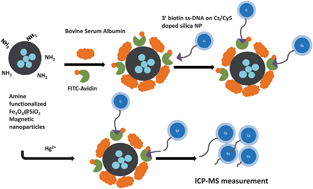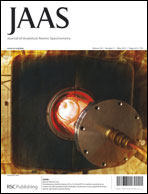Metal/dye-doped core-shell silica nanoparticles for potential use in bioassay†
Abstract
Nanoparticles (NPs) have become an important material used to detect bio-targets at the molecular level with accurate quantification and multiplex detection, in conjunction with inductively coupled plasma-mass spectrometry (ICP-MS). Various types of NPs have been developed so far for selective tagging of a wide range of bio targets. In this work, metal and dye, both doped silica core-shell NPs with the combination of Cs and Cy5, Cd and RhBITC, and Pb and FITC were synthesized for particle tagging and characterized by ICP-MS. For the metal and dye doping, metal salts and dyes were seeded together during the core formation, and then the surface was covered with silica shell. The developed synthesis method will provide an important opportunity to produce silica NPs (SNPs) bearing various metal ions for multiplex detection. In addition, fluorescence from the doped dye offers a tool to monitor the particle loss during the treatment procedures. No leaching of doped Cd into 2% nitric acid was observed for 18 days. The estimated average numbers of Pb, Cs and Cd atoms in each NP were in the range of 3.3 × 104 to 2.7 × 106 atoms, and the limit of detection was about 64.6 particles for Pb, 7.7 particles for Cs, and 11.8 particles for Cd. For demonstration of potential bio application, the synthesized Cs/Cy5-doped core-shell SNPs were used to monitor ss-DNA cleavage through Fenton-type reaction.


 Please wait while we load your content...
Please wait while we load your content...